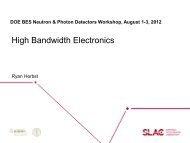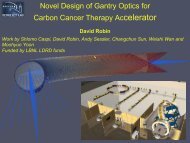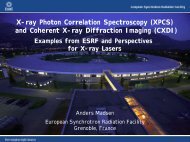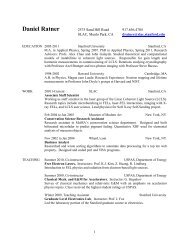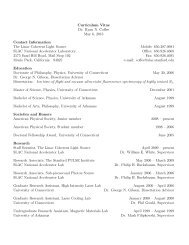SXR Technical Design Report - Stanford University
SXR Technical Design Report - Stanford University
SXR Technical Design Report - Stanford University
You also want an ePaper? Increase the reach of your titles
YUMPU automatically turns print PDFs into web optimized ePapers that Google loves.
5. Instrument Layout:<br />
In this section we will describe the constraints on the physical layout of the <strong>SXR</strong> systems and how we<br />
propose to meet the scientific requirements within those constraints. The proposal conforms to the new<br />
AMO experiment location in the first hutch of the Near Experimental Hall (NEH) on the 83 mrad line. The<br />
<strong>SXR</strong> systems are on the 28 mrad line, between the AMO line and the hard x-ray line, with a premonochromator<br />
sample position, M1 mirror and grating system in first hutch. The <strong>SXR</strong> exit slit,<br />
refocusing mirror and end station are in the second hutch.<br />
In the Front End Enclosure (FEE) the M3-S1 or M3-S2 mirrors of the Soft x-ray Optics Mirror System<br />
(SOMS) direct the FEL beam down either the 83 mrad or the 28 mrad lines to the AMO and <strong>SXR</strong><br />
experiments respectively. On each branch there are fixed collimators and insertable photon stoppers in the<br />
FEE that block the beam, so entry can be permitted into the first hutch. Just down stream of the first hutch<br />
wall there is an insertable beam position imaging system and an isolation valve. This terminates the SOMS<br />
vacuum system.<br />
The basic optical layout is presented in section 3. There are several constraints on fitting this optical<br />
design into the NEH. The first is that it does not materially interfere with the program on the AMO<br />
experiment. Both requirements are physical, over space, and operationally for access during operations on<br />
each system. A second is the flux in the FEL beam. Though power is on average low, the flux density in<br />
the FEL beam will damage most materials. This is particularly critical where the beam is focused. The third<br />
requirement is the inclusion of a moderately high resolution monochromator, which essentially requires it<br />
span the first and second hutches.<br />
The AMO group is locating their experiment in the first hutch of the NEH. The <strong>SXR</strong> beam will pass<br />
through the first hutch, horizontally between the AMO experiment and the hard x-ray beam line. The first<br />
experimental station and the monochromator would be located in the first hutch just up stream of the AMO<br />
focusing optics. These would have to be properly shielded for personnel to be in the first hutch while beam<br />
is passing through the <strong>SXR</strong> monochromator into the second hutch. These shielding requirements have not<br />
yet been defined. The controls on the shielding will follow SLAC personnel protection requirements. This<br />
shielding and controls will be required for the <strong>SXR</strong> experiment to run effectively. The hard x-ray beam line<br />
that also passes through the first hutch will be shielded.<br />
The flux density in the FEL beam will damage most materials and is particularly critical where the beam is<br />
focused. Materials of low Z elements have the best properties for surviving in the beam [3]. Collimators<br />
and beam stops are to be fabricated from B 4 C which should not damage in the unfocused FEL beam at this<br />
distance from the source. At approximately 0.12 eV/atom/pulse fatigue sets in and at 0.6 eV/atom/pulse<br />
single shot damage occurs in B 4 C. The fatigue value sets a limit for optics and beam stops that are<br />
continuously or often in the beam. Collimator and apertures that will only see incidental beam strikes are<br />
limited at the higher single shot damage threshold. The monochromator proposed in section 3 focuses, in<br />
one dimension, both the monochromatic and the zero order, white, beam at the exit slit. All materials are<br />
likely to damage in the focused zero order beam at the exit slit. Thus the exit slit must be opened when<br />
zero order light is put through it to prevent damage to the slit blades. This does not substantially limit the<br />
ultimate focus at the second experimental station as the zero order focus is quite small, 1σ ~10μm. An<br />
aperture up stream of this zero order flux density ‘stay clear’ would contain the beam and prevent the<br />
focused zero order beam from striking the open exit slits.<br />
5.1 Instrument Configuration:<br />
The <strong>SXR</strong> proposal is predicated on the inclusion of a monochromator, which essentially requires the<br />
optical system to span the first and second hutches of the NEH. The basic layout is shown in figure 5.1. The<br />
transmission sample position and the monochromator focusing/grating system will be located in the first<br />
hutch along with, but up stream of, the AMO experiments. The <strong>SXR</strong> is laid out to make space for an<br />
extension of AMO experimental systems into the second hutch.<br />
20



